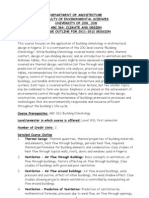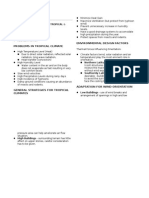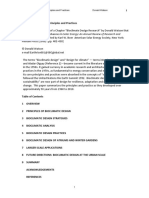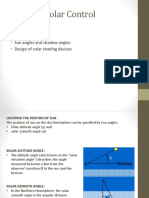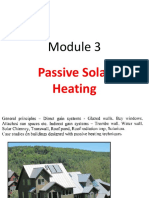Shading and Redirecting Light: Shades
Uploaded by
Michelle MirandaShading and Redirecting Light: Shades
Uploaded by
Michelle MirandaShading and Redirecting Light
Shading is the use of building elements to avoid direct sunlight, in order to avoid excessive light or solar heat gain. Redirecting light is the use of building elements to bounce sunlight into more desirable locations in the building. Shading is an important set of strategies for visual comfort and thermal comfort. As such, successful shading is measured by the overall success of visual and thermal comfort. Shading strategies include overhangs, louvers, and vertical fins. Light redirection strategies include light shelves and baffles. All of these strategies can be external to the building or internal, and can be fixed-position or adjustable. Some elements both shade and redirect light at the same time. Both thermal comfort and visual comfort should be considered simultaneously when designing these elements, as they affect both.
Shades
Shades can keep the heat and glare of direct sun from coming through windows, while still allowing diffuse light and views to enter. They can also keep direct sunlight off of walls or roofs, to reduce cooling loads. Interior shades do not block solar heat gain, but can block glare and evenout light distribution.
Interior shades can improve visual comfort, but do not block out solar heat gain The most common form of shade is an exterior fixed horizontal overhang. These are used on the side of the building facing the sun's path, sometimes including east and west faces. However, east and west faces often have more need of vertical fins to avoid low-angled sun. The side of the building facing away from the equator needs no shading, except near the equator where the sun may be on the north or south side depending on the season. There are many variations on fixed external shades, to reduce the profile and/or let more diffuse light in.
Common shading strategies Lawrence Berkeley Lab's "Tips for Daylighting With Windows" In hot climates, it can be especially useful to shade the building's roof to avoid solar heat gain. Rooftop solar panels, if placed right, can act as shades and thus perform double duty as energy generators and energy load reducers.
Adaptive Shades
Shading can be designed to allow the sun's light and heat into the building at some times of day or year, while rejecting it at other times. The simplest method for this is to use a fixed horizontal overhang whose width is calculated to shade during summer months when the sun is high, and allow the sunlight in during winter months when the sun is at a lower angle.
An overhang shades in summer but lets heat in during winter You can calculate the sizes for such overhangs on your site with the Ecotect Shading Device Wizard. Shading can also be adapted by making it movable--either manually operated by occupants or automatically controlled. Such systems can be much more responsive and finely tuned, but they are also more expensive, and require more maintenance and repair over the years. Useroperated systems may require occupant training, and are often not properly used.
Light Shelves and Baffles
To evenly distribute light, it is often desirable to bounce sunlight off of surfaces. Direct sunlight on work surfaces often causes glare. Light shelves are devices that both shade view windows from glare and bounce light upward to improve light penetration and distribution.
A light shelf is generally a horizontal element positioned above eye level that divides a window into a view area on the bottom and a daylighting area on the top. It can be external, internal, or combined and can either be integral to the building, or mounted upon the building.
A light shelf avoiding glare and pulling daylight deeper into the room Light shelves are most effective on walls facing the sun's path; on pole-facing walls they simply act as shades. Light shelves on east and west orientations may not bounce light that much further into the spaces, but are an effective means of reducing direct heat gain and glare. Exterior light shelves reduce daylight near the window but improves the light uniformity. The recommended depth of an external light shelf is roughly equal to its height above the work plane. To reduce cooling loads and solar gain, an exterior light shelf is the best compromise between requirements for shading and distribution of daylight. Because they are only shades, they do not change the ratio of incoming light to heat, but better distribution of light can reduce the amount needed in a space, which helps with cooling. Light shelves may be constructed of many materials, such as wood, metal panels, glass, plastic, fabric, or acoustic ceiling materials. Considerations that affect the choice of material include structural strength, ease of maintenance, cost, and aesthetics. Light shelves and vertical fins do not need to be opaque; when they are transparent but diffusive, they can help evenly distribute light without reducing the total amount of light significantly.
Diffusing glass fins on a west-facing wall help distribute light evenly without reducing incident light.
Sizing Light Shelves
The orientation, height, position (internal, external, or both), and depth of the light shelf are critical. A rule of thumb is that the depth of the internal light shelf be approximately equal to the height of the clerestory window head above the shelf. Optimal width and placement of light shelves depends on the site's location and climate. To simulate this, you can useAutodesk Ecotect software.
Baffles
When light shelves are oriented vertically, they are known as baffles. They are used with skylights or roof monitors to better distribute daylight and avoid glare. Designing the optimal height and placement of baffles is done the same way as designing light shelves.
Baffles in a roof monitor avoid direct glare while bringing in the sun's full brightness
ADJUSTABLE SHADING Adjustable shading allows the user to choose the desired level of shade. This is particularly useful in spring and autumn when heating & cooling needs are variable. Note: active systems require active users. Climate Change Climate change does not affect sun angles, but the desirability of shade or solar gain may change, this affecting the overall design strategy.
Adjustable shading (mechanical or seasonal vegetation) will facilitate adaptation to changing climatic conditions. Northern elevations Adjustable shading appropriate for northern elevations includes adjustable awnings or horizontal louvre systems above glazing, and removable shadecloth over pergolas or sails. Shadecloth is a particularly flexible and low cost solution.
Eastern and western elevations Adjustable shading is particularly useful for eastern and western elevations, as the low angle of the sun makes it difficult to get adequate protection from fixed shading. Adjustable shading gives greater control while enabling daylight levels and views to be manipulated. Appropriate adjustable systems include sliding screens, louvre screens, shutters, retractable awnings and adjustable external blinds. North-east and north-west elevations Adjustable shading is recommended for these elevations as they receive a combination of high and low angle sun throughout the day. Typical responses for northern and eastern or western elevations need to be integrated. Select systems which allow the user to exclude all sun in summer, choose full sun in winter, and manipulate sun levels at other times. CLIMATE SPECIFIC RESPONSES Hot humid climates and Hot dry climates with warm winters: Shade the building and outdoor living spaces throughout the year. All other climates: Use appropriate passive solar design principles. [See: Australia's Climate Zones; 4.1 Passive Design; 4.5 Passive Solar Heating; 4.6 Passive Cooling]
Hot humid climates Shade all external openings and walls including those facing south. Use covered outdoor living areas such as verandahs and deep balconies to shade and cool incoming air. Use shaded skylights to compensate for any resultant loss of natural daylight.
Choose and position landscape to provide adequate shade without blocking access to cooling breezes. Use planting instead of paving, to reduce ground temperature and the amount of reflected heat. A 'fly roof' can be used to shade the entire building. It protects the core building from radiant heat and allows cooling breezes to flow beneath it. Hot dry climates
Shade all external openings in regions where no winter heating is required. Provide passive solar shading to north facing openings in regions where winter heating is required. Avoid shading any portion of the glass in winter - use upward raked eaves to allow full winter solar access, or increase the distance between the window head and the underside of the eave. Use adjustable shade screens or deep overhangs (or a combination of both) to the east and west. Deep covered balconies or verandahs shade and cool incoming air and provide pleasant outdoor living space. Place a shaded courtyard next to the main living areas to act as a cool air well. Tall, narrow, generously planted courtyards are the most effective when positioned so that they are shaded by the house.
Use planting instead of paving, to reduce ground temperature and the amount of reflected heat. Warm humid and warm/mild temperate climates
Provide passive solar shading to all north facing openings, using shade structures or correctly sized eaves Use adjustable shade screens or deep overhangs to the east and west. Adjustable shade screens are the most effective at excluding low angle sun. Cool temperate climates Do not place deep covered balconies to the north as they will obstruct winter sun. Balconies to the east or west can also obstruct winter sun to a lesser extent Avoid shading any portion of the north facing glass in winter- use upward raked eaves to allow full winter solar access, or increase the distance between the window head and the underside of the eave. Use deciduous planting to the east and west. Avoid planting to the north which obstructs solar access. USING PLANTS FOR SHADING Match plant characteristics (such as foliage density, canopy height and spread) to shading requirements. Choose local native species with low water requirements wherever possible. In addition to providing shade, plants can assist cooling by transpiration. Plants also enhance the visual environment and create pleasant filtered light. [See: 2.4 Sustainable Landscapes]
Deciduous plants allow winter sun through and exclude summer sun. Trees with high canopies are useful for shading roofs and large portions of the building structure.
Shrubs are appropriate for more localised shading of windows. Wall vines and ground cover insulate against summer heat and reduce reflected radiation. SHADING AND DAYLIGHT Choose shading methods that allow adequate amounts of daylight into the building while preventing unwanted heat gain. Select plants that allow filtered light into the building. [See: 2.4 Sustainable Landscapes] Design glazing to admit maximum light for minimum heat gain. Clear sections in verandah roofs can be useful. [See: 4.10 Glazing] Light coloured external surfaces or shading devices reflect more light into the building. Depending on the situation this can be beneficial, or it can create unwanted glare. SHADING FOR A HEALTHIER ENVIRONMENT Appropriate shading practices reduce the chance of exposure to harmful UV rays. Planting is a low cost, low energy provider of shade that improves air quality by filtering pollutants.
You might also like
- Unit 1 - Introduction To Intelligent Buildings75% (4)Unit 1 - Introduction To Intelligent Buildings58 pages
- UJ ARC 364 Climate and Design Course Outline 120311aNo ratings yetUJ ARC 364 Climate and Design Course Outline 120311a5 pages
- CG Building Components and Materials PDFNo ratings yetCG Building Components and Materials PDF3 pages
- Green Surfaces: Known As "The Green Space of Qeshm Island"No ratings yetGreen Surfaces: Known As "The Green Space of Qeshm Island"5 pages
- Defining Climatic Zones For Architectural Design in NigeriaNo ratings yetDefining Climatic Zones For Architectural Design in Nigeria14 pages
- Visual Comfort in The Organic Architecture of An INo ratings yetVisual Comfort in The Organic Architecture of An I5 pages
- Insulation Installation: - Provide Hot Air - Choose Windows With MaximumNo ratings yetInsulation Installation: - Provide Hot Air - Choose Windows With Maximum20 pages
- Contents of Drawings: ASTU, SOCEA, DAUP, Basic Architectural Design II, February 2023No ratings yetContents of Drawings: ASTU, SOCEA, DAUP, Basic Architectural Design II, February 20233 pages
- Presentation Sustainable Buildings and Green MarketsNo ratings yetPresentation Sustainable Buildings and Green Markets32 pages
- Bioclimatic Design Principles and PractiNo ratings yetBioclimatic Design Principles and Practi30 pages
- Retrofitting Existing Buildings To Improve Sustainability and Energy Performance - WBDG - Whole Building Design GuideNo ratings yetRetrofitting Existing Buildings To Improve Sustainability and Energy Performance - WBDG - Whole Building Design Guide10 pages
- AIC Building Measurement Guidelines-2013-11-18No ratings yetAIC Building Measurement Guidelines-2013-11-1812 pages
- Sustainable Site Responsive ArchitectureNo ratings yetSustainable Site Responsive Architecture19 pages
- 2ar8 TD Presentation - Ang - Manto - Querido - Raqueno - TahilNo ratings yet2ar8 TD Presentation - Ang - Manto - Querido - Raqueno - Tahil17 pages
- Lecture 01-Building Science For DesignerNo ratings yetLecture 01-Building Science For Designer18 pages
- PDF Fundamentals of Building Construction: Materials and Methods 7th Edition (eBook PDF) download100% (5)PDF Fundamentals of Building Construction: Materials and Methods 7th Edition (eBook PDF) download55 pages
- Green Architecture: A Guide To Understanding Characteristics of Sustainable BuildingsFrom EverandGreen Architecture: A Guide To Understanding Characteristics of Sustainable BuildingsNo ratings yet
- Sustainable Architecture: A Solution to a Sustainable Sleep-out Design Brief. Volume 2.: Sustainable Architecture - Sustainable Sleep-out Design Brief, #2From EverandSustainable Architecture: A Solution to a Sustainable Sleep-out Design Brief. Volume 2.: Sustainable Architecture - Sustainable Sleep-out Design Brief, #2No ratings yet
- MUSLIM SPACE and The Philippine Islamic Architecture0% (2)MUSLIM SPACE and The Philippine Islamic Architecture71 pages
- Salutations in Letters and Email: Rules For Business LettersNo ratings yetSalutations in Letters and Email: Rules For Business Letters7 pages
- Michelle G. Miranda Multiple Choice-Dividends and Dividend PolicyNo ratings yetMichelle G. Miranda Multiple Choice-Dividends and Dividend Policy4 pages
- Capital Expenses or Expenditures Are Payments by A Business For Fixed Assets, Like BuildingsNo ratings yetCapital Expenses or Expenditures Are Payments by A Business For Fixed Assets, Like Buildings4 pages
- Investment Opportunities and Market Reaction To Capital Expenditure DecisionsNo ratings yetInvestment Opportunities and Market Reaction To Capital Expenditure Decisions20 pages








